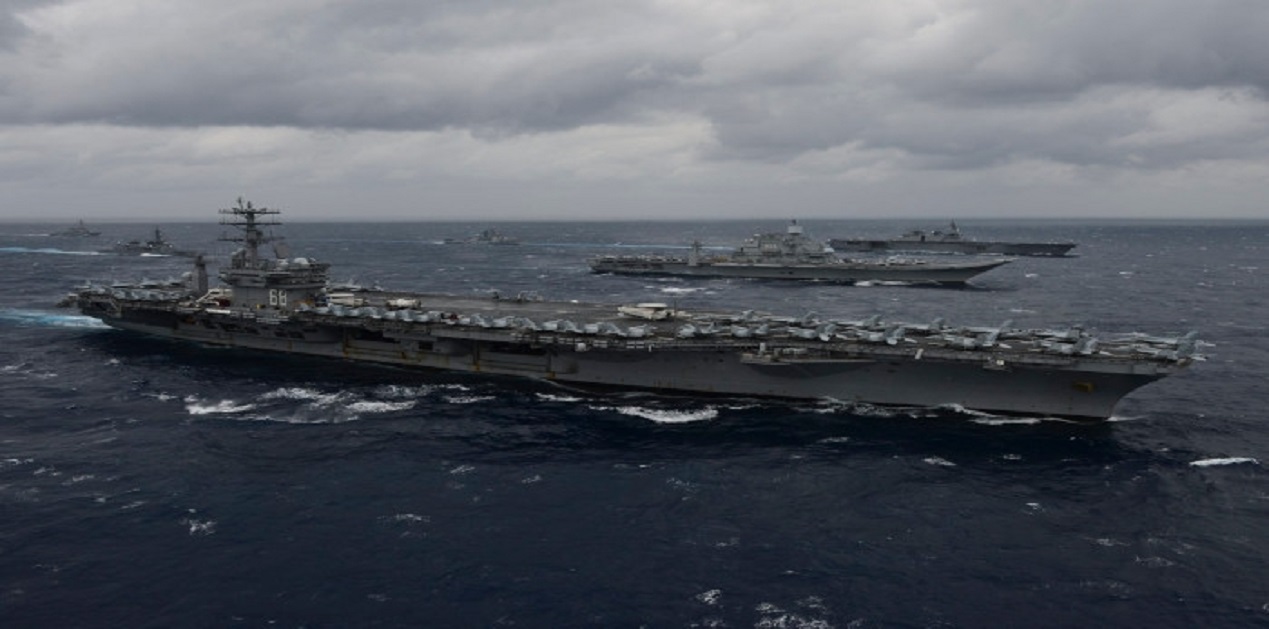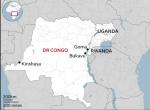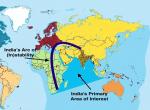Malabar 2021
The Phase-II of Indian Navy’s (IN) Multilateral Maritime Exercise Malabar2021 (25thedition) kicked off in the Bay of Bengal on 12 October 2021 with participation from the Japan Maritime Self Defence Force (JMSDF), Royal Australian Navy (RAN) and the United States Navy (USN). The exercise will culminate on 15 October 2021. [1] Phase-I of the exercise was held in the Philippines Sea from 26 – 29 August 2021. The aim of this phase was to enhance inter-operability, gain from best practices and develop a common understanding of procedures for Maritime Security Operations. Complex surface, sub-surface and air operations including live weapon firing drills, anti-surface, anti-air and anti-submarine warfare drills, joint manoeuvres and tactical exercises were conducted.
In the ongoing Phase II, IN participation includes destroyer Ranvijay, frigate Satpura, P8I Long Range Maritime Patrol Aircraft (MPA) and a submarine. The USN has deployed nuclear powered Aircraft Carrier USS Carl Vinson along with two destroyers, USS Lake Champlain and USS Stockdale. The JMSDF has deployed helicopter carrier JS Kaga and Murasame-class destroyer JS Murasame, while Royal Australian Navy has fielded HMAS Ballarat and HMAS Sirius. [2] This phase will build upon inter-operability developed during Phase I and focus on advanced surface and anti-submarine warfare exercises and weapon firings. [3]
History and Evolution of Malabar Naval Exercise
Malabar series of maritime exercises commenced in 1992 as a bilateral IN-USN exercise and has grown in scope and complexity over the years to include four navies of the Pacific and Indian Ocean Region- those of QUAD states. [4]Exercise Malabar II was held in 1995 and in 1996 Malabar III was the last Indo-U.S. military exercise before military ties were suspended following India’s nuclear tests in 1998. These were revived following 9/11, and saw an expansion in the scope and number of combined exercises. From 2002 onward, the exercise has been conducted every year. Interestingly Malabar 2007 also saw the participation of Singapore, Japan, and Australia figuring three aircraft carriers, 28 surface vessels, 150 aircraft, and over 20,000 personnel, making it one of the largest multilateral naval exercises ever held in the Bay of Bengal. This led to Beijing issuing démarches to all five participating countries. India’s justification was that it had combined the existing bilateral exercises with Singapore to save costs and efforts and it subsequently discontinued participation by Japan, Singapore, and Australia in future Malabar series. With the Modi government coming to power in 2014, Japan was once again invited for Malabar 2015 and has participated every year since. Malabar 2015 was seen as an advanced exercise, involving U.S. Navy aircraft carrier and a nuclear submarine, and a Kilo-class submarine and a P-8I MPA of IN. Malabar 2017, went a step further with three carriers; USS Nimitz, INS Vikramaditya, and JS Izumo, Japan’s helicopter carrier. Malabar 2017 was said to be one of the most advanced level combined naval exercise ever undertaken by the Indian Navy. The 2018 edition was conducted off the coast of Guam in the Philippine Sea and off the coast of Japan in 2019.
The 2020 edition saw the participation of the Royal Australian Navy[5] which was invited post Chinese aggressive actions across the LAC in Ladakh. [6] Australia participated in Malabar after a gap of 13 years effectively making it an exercise of the QUAD members. Earlier, despite the 2017 Doklam conflict, India had rejected Australia’s request to participate in Malabar exercises for a fourth year in a row. The 2020 edition was conducted in the Bay of Bengal, and Arabian Sea. “Dual carrier” operations were carried out — joint operations centred around the Vikramaditya carrier battle group of the IN and the Nimitz carrier strike group of the USN. The two carriers, along with other ships, submarines, and aircraft of the participating navies, engaged in high-intensity naval operations, including cross-deck flying operations and advanced air defence exercises by MiG 29K fighter aircraft from the Vikramaditya, and F-18 jets and E2C Hawkeye airborne early warning (AEW) aircraft from the Nimitz. Advanced surface and anti-submarine warfare exercises, seamanship evolutions, and weapon firings were also undertaken. [7]
The exercises during Malabar are based on common tactical drills and procedures as per NATO Multinational Tactical Publications series (MTP) and a dedicated secure communication and intelligence exchange system Centrixs (Combined Enterprise Regional Information Exchange System), specifically designed for use between the U.S. Navy and its coalition partners. [8]
Malabar and QUAD
The evolution of Malabar exercise over the years and India’s increasing and unabashed engagement in QUAD is a clear reflection of India shedding its geo-political stance of ‘non-alignment’ in favour of ‘strategic autonomy’ which entails a flexible understanding and application and has national interests central to the concept. Eminent Indian scholars in recent years have argued that in the face of serious threats, alignments can actually enhance strategic autonomy. Strategic autonomy is best achieved through strategic partnerships, focussing on India’s interests and the means to secure them and India’s engagement in QUAD, enhances its strategic autonomy vis-à-vis China. External Affairs Minister S. Jaishankar in September 2020 urged India to “step out, shape the world more actively, engage other players more confidently, be much clearer about what our own interests are and try and advance them.” He suggested India may already be looking even beyond the horizons of strategic autonomy.[9]
Malabar joint naval exercise has become the unofficial yet quintessential facet of QUAD’s security cooperation in the maritime domain as it was the most suitable engagement that could bring together the capabilities of the four QUAD members which are connected by the maritime medium and share concerns and interests in the Indo-Pacific maritime domain. Although QUAD clearly steers clears of projecting itself as a military alliance or any grouping targeted against any specific country (China), Malabar exercise finds collective acceptance by the QUAD members being ostensibly in line with the recent joint statement of QUAD leaders that announces “commitment to promoting the free, open, rules-based order, rooted in international law ….to bolster security and prosperity in the Indo-Pacific ….. we stand by rule of law, freedom of navigation and over-flight….. territorial integrity of states. ……..we will continue to champion adherence to international law, particularly UNCLOS, to meet challenges to the maritime rules-based order, including in the East and South China Seas.” [10] Even the Chinese media has reported this edition of Malabar as “the first joint maritime exercise within the framework of QUAD in the Western Pacific apparently aimed to overawe China” [11] and sees it as a response to the rising tensions between China and the US on multiple fronts, from Taiwan and Southeast Asia to Afghanistan[12]
How China perceives QUAD/ Malabar
Articulations by Chinese analysts and media reflect diverse perspectives on the developments vis-à-vis QUAD and Malabar exercise. Some have called the expanded Malabar exercise involving all the QUAD members an ill-intentioned attempt to corner China and a hollow bluff. [13] Doubts are cast over the ability of QUAD members to check China's rise with their joint exercises that merely focus on anti-submarine warfare operations. [14]
Viability of QUAD and joint exercises is seen as suspect as India is expected to strongly vie for greater regional dominance as the sole power in the Indian Ocean and not be subject to the US. As India is not expected to open up its military bases to US troops for permanent stationing, cooperation among QUAD members is envisaged as tactical at best, not transcending to the strategic level.
Formalization of QUAD into a NATO-like alliance or Asian NATO is therefore not envisaged by the Chinese analysts. A US driven "Asian NATO" with Japan and Australia in the Western Pacific region is however not ruled out. India’s military and defence cooperation with Japan is seen to be subject to the will of the US and any cooperation with Australia as superficial, there being no drivers for joint military activities between the two countries. [15]
At the same time Beijing considers QUAD’s efforts including the Malabar exercises, as being aimed at “containing” China’s growing global profile and footprint. In response to the ongoing Malabar exercise, which China views as the first joint maritime exercise within the framework of QUAD in the Western Pacific aimed at pressurising China[16], Beijing has stepped up its naval exercises and has conducted live ammunition training in the South China Sea, Yellow Sea and Bohai Strait. The exercises were ostensibly a show of force and strength to the U.S. and its Indo-Pacific partners. [17]
Upgrading the US-India bilateral naval exercise Malabar into a QUAD joint military exercise is seen as a US maritime strategy to enhance its depleted conventional deterrence capability in the Western Pacific against China by uniting allies and strategic partners. The deepening security cooperation in the QUAD mechanism by way of joint military exercises and intelligence sharing is viewed with concern by Beijing as it applies strategic pressure on China and a definite need is expressed to counter the strengthening of the security cooperation among the QUAD countries. [18]
Going Forward
With the signing of Mutual Logistics Support Agreement (MLSA) between India and Australia in June 2020, all the QUAD members now bilaterally have an MLSA. The tempo generated by the recent expansion of the Malabar exercises needs to be sustained and taken forward towards a more comprehensive and streamlined cross logistics exchange and support between members which can be honed over time during Malabar exercises. This would provide operational flexibility, economy of effort and resources, and present a very credible deterrence in the Indo-Pacific region. Similarly, among Australia-Japan-U.S, all three have Reciprocal Access Agreement (RAA) bilaterally, except between Australia and Japan which is pending implementation. RAA enables easy access to each other’s ports and airfields. Vessels can thus make port calls regularly for resupply, crew rest, avoiding protracted bureaucratic procedures. [19] This aspect could come up for consideration vis-à-vis India. The handicap in operational engagements of these countries with India would have to be factored and way ahead evolved.
Another key capability that the QUAD members need to develop is going beyond interoperability with friendly nations and graduate to ‘interchangeability’, an example of which is the deployment of US Marine Corps F 35 fighter aircraft on the UK aircraft carrier. [20] These aspects would be critical for developing effective military cooperation, interoperability and deterrence.
The QUAD need not and may not formalize itself into a NATO like military alliance given the geographical separation, differing threat perceptions and national interests, and geo-political variances among its members. However, the teeth of the mechanism and a viable deterrent against increasingly assertive and aggressive China is the joint maritime power of the members which is best harnessed and sharpened through the Malabar Joint Exercises.
References
[1] India Today, “Second phase of Malabar exercise from Oct 12-15”, 10 Oct 21, https://www.indiatoday.in/india/story/second-phase-malabar-exercise-us-deploy-nuclear-powered-aircraft-1863268-2021-10-10
[2] MoD, Press Information Bureau, 22 Aug 21,https://pib.gov.in/PressReleaseIframePage.aspx?PRID=1747992
[3]Indian Navy Press Release, https://www.indiannavy.nic.in/content/multilateral-maritime-exercise-malabar-2021-%E2%80%93-phase-ii-bay-bengal-12-%E2%80%93-15-october-21
[4][4]Ibid
[5]The Hindu, 22 Aug 21, https://www.thehindu.com/news/national/two-indian-naval-ships-arrive-in-guam-to-take-part-in-malabar-exercise/article36044432.ece
[6]The Diplomat - The Quad Conducts Malabar Naval Exercise,27 Aug 21, https://thediplomat.com/2021/08/the-quad-conducts-malabar-naval-exercise/
[7]The Indian Express - The Malabar Exercise of Quad nations, and why it matters to India, 31 Aug 21, https://indianexpress.com/article/explained/malabar-exercise-of-quad-nations-why-it-matters-to-india-7472058/
[8]Shishir Upadhyaya, India’s Maritime Strategy-Balancing Regional Ambitions and China, Routledge,2020, Pp167-170
[9]Jeff M Smith, Strategic autonomy and India US relations, Heritage Foundation, 09 Nov 2020, https://www.heritage.org/asia/commentary/strategic-autonomy-and-us-indian-relations
[10]https://www.whitehouse.gov/briefing-room/statements-releases/2021/09/24/joint-statement-from-quad-leaders/?utm_source=pocket_mylist
[11]Global Times, 26 Aug 21, https://www.globaltimes.cn/page/202108/1232599.shtml
[12]South China Morning Post, 23 Aug 21, https://www.scmp.com/news/china/diplomacy/article/3146085/us-led-quad-plans-joint-naval-exercises-china-tensions-boil
[13]The Global Times, 03 Nov 20, https://www.globaltimes.cn/page/202011/1205583.shtml
[14]Global Times, 03 Nov 2020, https://www.globaltimes.cn/page/202011/1205586.shtml
[15]The Global Times, 20 Oct 20, https://www.globaltimes.cn/page/202010/1204103.shtml
[16]Global Times, 26 Aug 21, https://www.globaltimes.cn/page/202108/1232599.shtml
[17]The Diplomat, The Quad Conducts Malabar Naval Exercise,27 Aug 21, https://thediplomat.com/2021/08/the-quad-conducts-malabar-naval-exercise/
[18]Global Times, Upgrading Quad and Malabar exercise shows US anxiety about China, 11 Aug 21, https://www.globaltimes.cn/page/202108/1231167.shtml
[19]John Bradford – “The QUAD has met - now it needs to get to work for maritime Asia”, Asia Maritime Transparency Initiative, 29 Apr 21, https://amti.csis.org/the-quad-has-met-now-it-needs-to-get-to-work-for-maritime-asia/?utm_source=pocket_mylist
[20]USNI News - US, UK Navies Working to Achieve Interchangeability, 20 Oct 2020, available at https://news.usni.org/2020/10/20/u-s-u-k-navies-working-to-achieve-interchangeability-in-carrier-forces-collaboration-on-unmanned-and-ai
(The paper is the author’s individual scholastic articulation. The author certifies that the article/paper is original in content, unpublished and it has not been submitted for publication/web upload elsewhere, and that the facts and figures quoted are duly referenced, as needed, and are believed to be correct). (The paper does not necessarily represent the organisational stance... More >>
Image Source: https://www.indiannavy.nic.in/sites/default/files/styles/photo_gallery_image_content/public/photo_gallery/edit2_46.jpg?itok=sJByrUAV











Post new comment